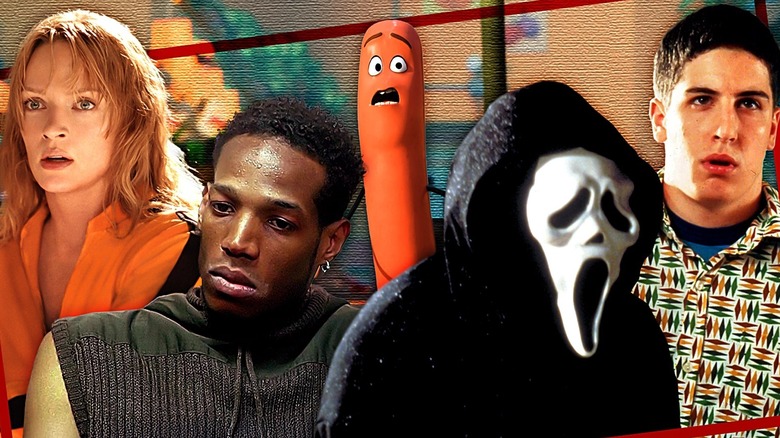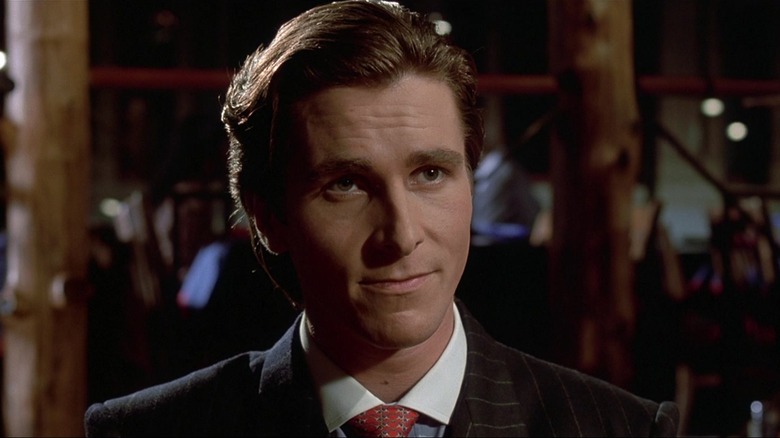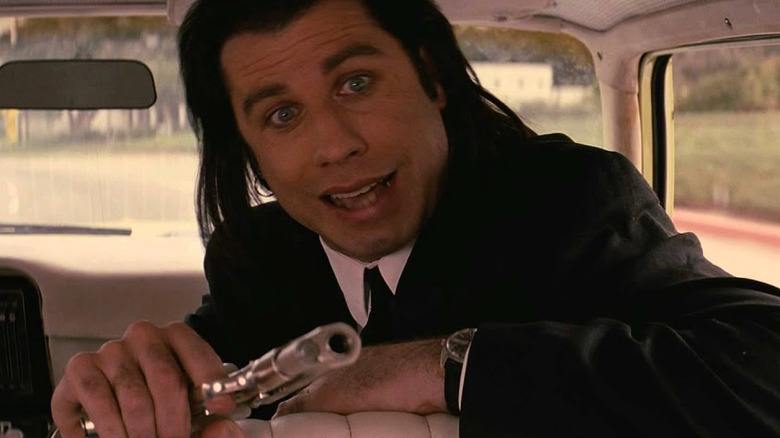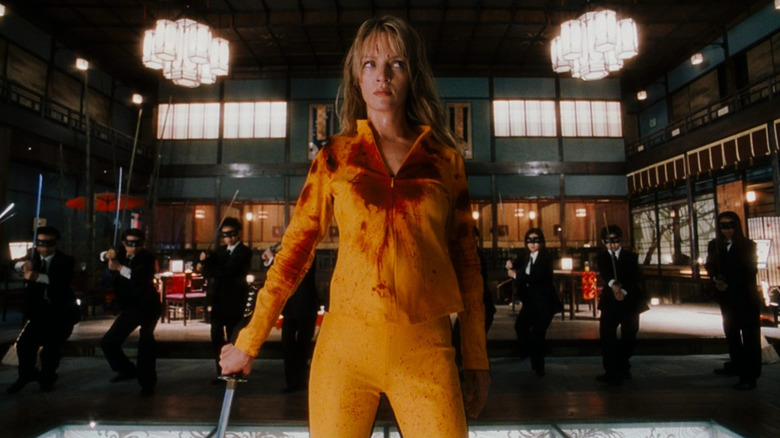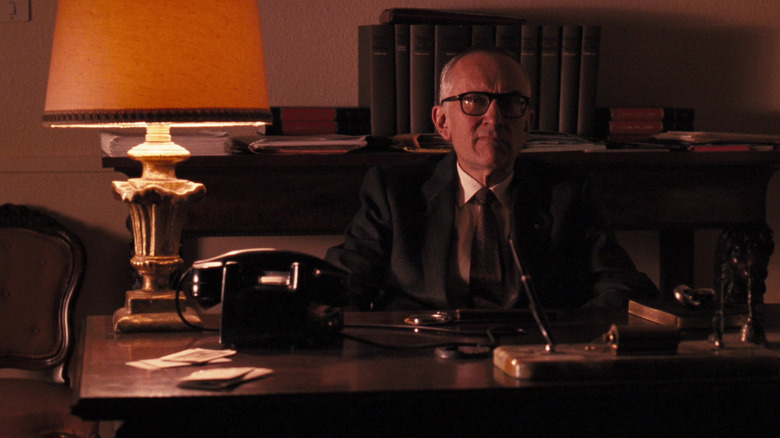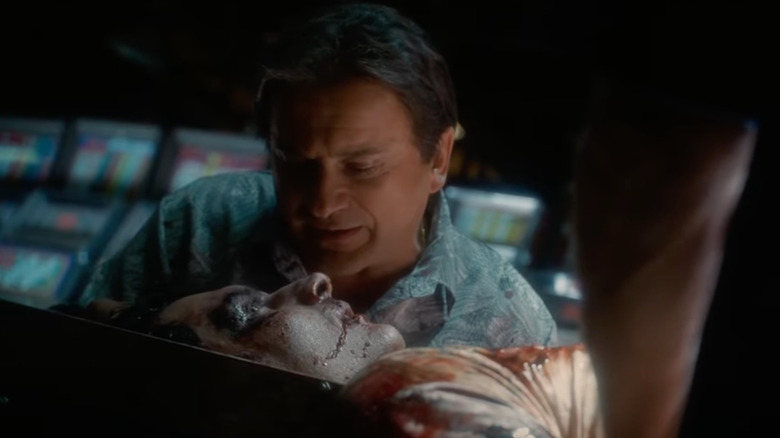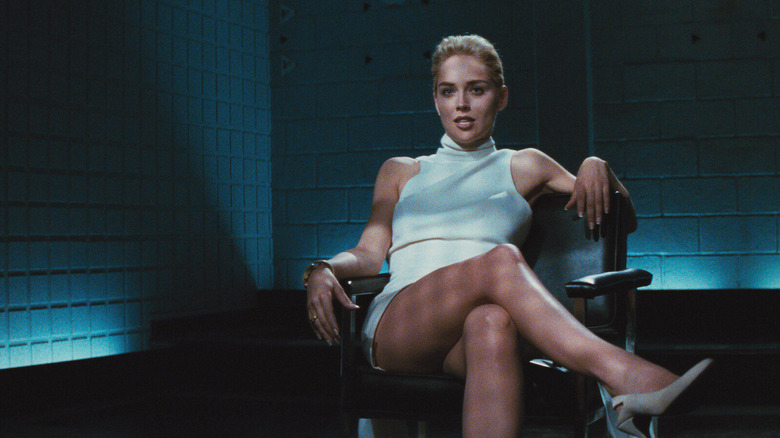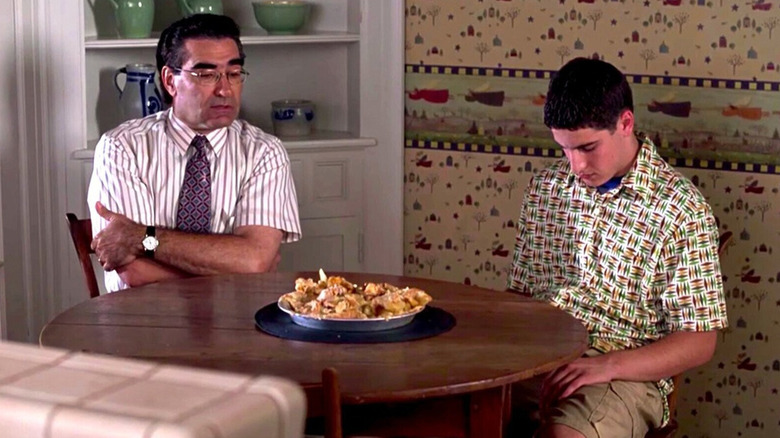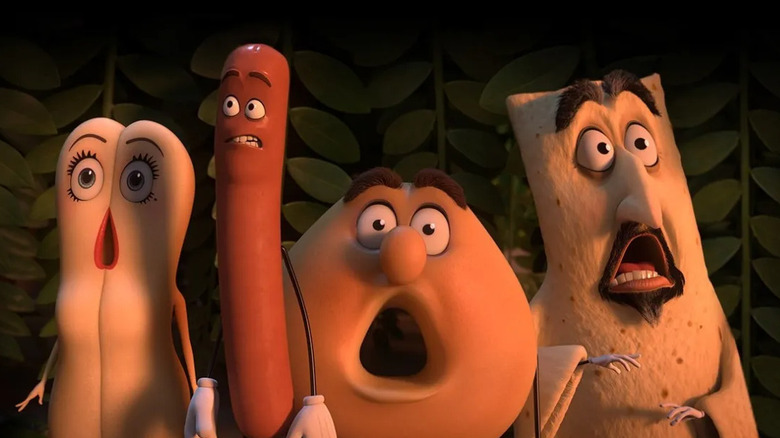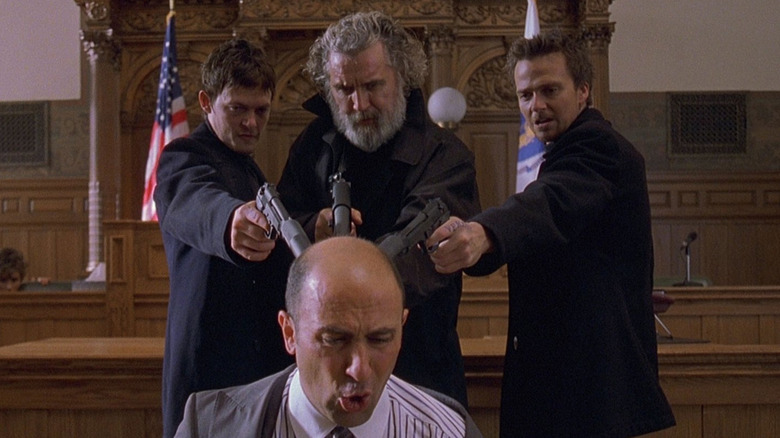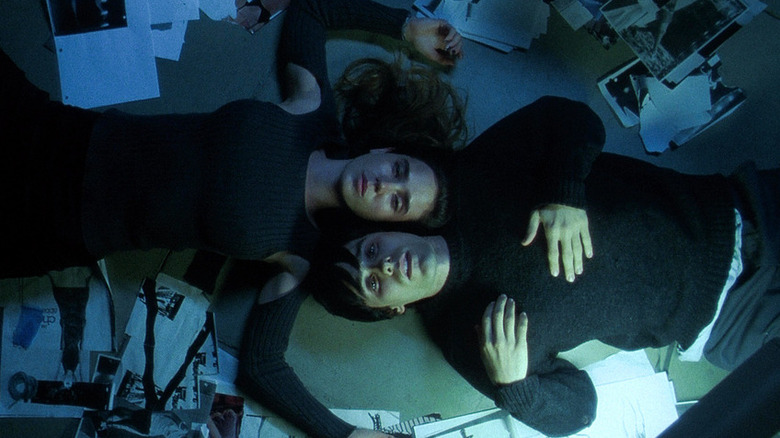12 Movies That Almost Got The Infamous NC-17 Rating
The NC-17 rating is a unicorn of sorts in the film industry — and for good reason. Indicating a film is forbidden screening for anyone 17 and under, NC-17 is a scarlet letter, a box office death sentence. Movies that earned the rating were previously exiled to straight-to-video releases, likely to be enjoyed in secrecy by voyeurs lurking around video rental stores (if they were on shelves at all).
Now, in the age of streaming, such a punishment doesn't spell doom the way it used to. Take "Blonde," the controversial Marilyn Monroe film that received an NC-17 rating just 3 years ago in 2022. The film, for as ambitious and messy as it was, found success in streaming numbers and even got awards recognition. (And, due to the fluid nature of streaming, surely a metric ton of teens 17 and under were able to view the movie.)
"Blonde" is a rare example of a movie that kept the racy elements of the original cut intact, despite the threat of an NC-17 rating. But for every film that earned the troublesome rating, there are about a dozen others that narrowly escaped it by making key edits to the final, theatrical versions. Interestingly, a majority of the most notable examples were movies of the '90s and '00s, eras that were ripe with gore, explicit sex, and drug use in the movies.
Here are 12 movies that escaped the infamous NC-17 rating.
Scream (1996)
As one of the best slasher movies of all-time nearly 30 years after release, Wes Craven's "Scream" brought a new edge to the slasher formula. That edginess, however, almost landed the movie in no-man's land with an NC-17 rating.
The Motion Picture Association of America (MPAA) took issue with two key parts of the film: the opening slow-mo stabbing of Casey before the opening title card and the stabbings between Billy and Stu in the kitchen near the ending. Speaking to The Hollywood Reporter in 2021, writer Kevin Williamson explained that there were compromises made to include both parts of the plot. Though MPAA "hated" the slow-mo stabbing scene, the "Scream" crew ultimately got to keep it because it was the only footage they had. There was no backup footage to include, and without it, the scene would have been stilted.
To balance out the inclusion of that scene, they opted to not show Stu and Billy's stab-fest at the end of the film. Williamson said, "There's three or four stabs that you just hear. Those were on camera originally, and they took them off because the MPAA were like, 'There's just too much.'" Even without the visual of the stabbing, the visceral disgust on Sidney's face still conveyed the emotional impact viewers were meant to feel in that moment.
The Saw franchise
The "Saw" franchise had a very sordid love affair with the NC-17 rating. Indeed, most of the films were originally rated NC-17 before editing at the behest of the MPAA. The first "Saw" cut a mere eight seconds during a particularly grisly scene. During the climactic moment Dr. Gordon (Carey Elwes) tries to save his family, he hacksaws his foot. Per The New York Times, the theatrical version shaved off eight seconds of gruesome images of the mutilated appendage, as well as Gordon's screams of agony. The full scene can be seen in the unrated version of the movie.
For the third installment of the franchise, the battle with the MPAA was even more exhausting. According to director Darren Lynn Bausman, "Saw III" was assigned an NC-17 rating six separate times before finally landing the R rating for theatrical release. The point of contention was the scene of Timothy Young's (Mpho Koaho) demise. The gnarly bone-breaking that led to his death, courtesy of a torture rack device, was deemed too horrific in its original form. Bausman said in a 2021 tweet that without the help of fellow horror director Rob Zombie, he couldn't have gotten "Saw III" to the coveted R rating.
American Psycho
What could be more fitting for a movie entitled "American Psycho" than a dispute with the MPAA over how gritty its depiction of sex, murder, and psychopathy was for the American public? "American Psycho" was America then, and in many ways, it's still America now. But the MPAA thought the truth as depicted in the film was a little too real in one particular scene. The Guardian detailed that the problematic scene was the one featuring a threesome between Patrick Bateman (Christian Bale) and two sex workers, during which Bateman performs anal sex.
Co-president of distributor Lionsgate Films, Mark Urman, told the New York Post at the time, "We tried to emphasize that the scene is completely defensible within the context of the movie [...] But the MPAA didn't really get it." The studio conceded and made edits to satisfy requirements for an R rating.
It will be interesting to see how Luca Guadagnino, the director for the new upcoming film adaptation, addresses sex and gore in a very different social landscape than the original.
Pulp Fiction
The first of two Quentin Tarantino entries on this list (a shock to no one who's ever seen a Tarantino film), "Pulp Fiction" narrowly escaped the dreaded NC-17 by including a decoy scene. As will be detailed throughout this list, directors can get creative with the cuts submitted to the ratings board in order to get the footage they actually want in the theatrical versions of their masterpieces. For "Pulp Fiction," Tarantino included a scene with Marvin's (Phil LaMarr) head exploding. A bit excessive, yes, but the director had a plan.
LaMarr spoke with Vanity Fair in 2013 and explained the plan for his death scene as detailed by Tarantino. In the R-rated version of the movie, he dies via gunshot to the head. LaMarr said, "There was some stuff that was potentially objectionable that he needed, and if you just give the ratings board the cut you want, they're going to go, 'No, you can't have that, you can't have that.' So he put in extra stuff to remove." The MPAA took the bait, Tarantino replaced the head exploding scene with the death scene he actually wanted and maintained the rest of the cut as he intended. It's all about the game and how you play it!
Kill Bill Vol. 1
Continuing the theme of Tarantino outsmarting the MPAA, "Kill Bill Vol. 1" got off with a slap on the wrist due to two savvy change by the director. According to The New York Times, Tarantino opted to have The Bride's (Uma Thurman) bloodiest meeting with the Crazy 88s shown in black and white to obscure the color of blood spatter in anticipation of an NC-17 rating. Additionally, another violent sequence — the story of O-Ren Ishii (Lucy Liu) — was shown as anime rather than live-action. Apprently animated violence is less "real" to the ratings board.
Minor edits to these scenes were made to achieve an R rating. If you're interested in the full-color version of the Crazy 88s scene, you'll have to seek out the Japanese edit of the movie. Although they were changes made out of necessity, the black-and-white and anime stylings featured in "Kill Bill Vol. 1" inspired similar, super-stylized editing choices for films that came after, like "Sin City." Meanwhile, we're still waiting for a proper release of "Kill Bill: The Whole Bloody Affair."
The Godfather Part III
Before the blood-spattering mob hits in "The Sopranos," the Corleone family was ordering executions on the big screen. With the final film in the "Godfather" trilogy, director Francis Ford Coppola wanted to go out with a bang (pun very much intended). "The Godfather Part III" was initially assigned an NC-17 due to the bloody nature of Don Licio Lucchesi's murder. According to the 1990 documentary "The Godfather Family: A Look Inside," the full version of the hit saw Michael Corleone's (Al Pacino) bodyguard Calo (Franco Citti) stab Lucchesi with his own glasses, complete with blood squirting from his neck. The full inclusion of the scene was a red flag for the MPAA.
To satisfy an R rating, Coppola trimmed the scene to show only the first contact of the stab and the aftermath, without the blood-spurting. The unedited version of the scene can be seen in the 2020 re-release of the movie, "The Godfather Coda: The Death of Michael Corleone."
Casino
Martin Scorsese and Quentin Tarantino read from the same playbook, but the trick they learned worked out better for Scorsese with "Casino."
The crime film starring Robert De Niro, Joe Pesci, and Sharon Stone was one of Scorsese's most violent to that point, so it wasn't a shock when it was initially assigned an NC-17 rating before release. The grossest (and yet, most iconic) scene in the film featured Nicky Santoro (Pescii) killing another mobster by having his head crushed in a vice. One of the dude's eyes popped out from the pressure!
Scorsese was fully prepared to omit the scene, hoping the MPAA would strike it over the other scenes and explicit language he wanted to keep. The movie was assigned the NC-17 rating on first submission. On an appeal, however, it was assigned an R rating even with the inclusion of Santoro's gratuitous death, as reported by Chicago Tribune. Perhaps Scorsese's veteran status helped him out, compared to the more novice Tarantino one year before.
Basic Instinct
Perhaps Sharon Stone had a thing for explicit projects, because another one of her best-known films makes this list in "Basic Instinct." Director Paul Verhoeven is no stranger to the NC-17. As legendary as "Basic Instinct" is, perhaps his second most popular work is the cult classic NC-17 film "Showgirls," which Verhoeven even admitted to wishing he made more like the Sharon Stone thriller.
In the case of "Basic Instinct," Verhoeven danced with the MPAA eight different times to reconcile the amount of sex in the film. He told Rolling Stone that it was "unpleasant" to repeatedly edit the film's steamier scenes down, but he was able to get away with the amount of sex generally because of "the element of threat." Meaning, most of "Basic Instinct's" sex wasn't there for the sake of it, but rather as a potential gateway to murder within the film's plot.
For what it's worth, despite his groaning, only 40 seconds were actually cut in the end. Verhoeven did note to the magazine, "Strangely enough [...] the shot of Sharon Stone spreading her legs was never a problem." Certainly every director on this list could question why the MPAA was okay with certain examples of violence, sex, or drug use over the one scene that nearly got them an NC-17, but as with every authoritative Hollywood body, their logic remains a mystery.
American Pie
Faulty logic aside, it's hard to blame the MPAA for their initial NC-17 rating for "American Pie." The lack of precent for pie-thrusting had them stumped.
Jason Biggs explained on Justin Long's "Life Is Short" podcast in 2020 that the ratings board understandably took issue with Biggs' character Jim practicing sex with a warm apple pie. There were no previous examples of such an act for the board to refer to, and the fact that this scene involved a teenager didn't help their case. After several meetings, the MPAA finally agreed to assign the movie an R rating on one condition: The number of thrusts into the pie had to be reduced. You can't make this up. Director Paul Weitz obliged, and so one of the most insane scenes ever committed to film was etched in history.
The raunchiness of "American Pie" connected with audiences, and the success of the first movie launched an unlikely billion-dollar franchise.
Sausage Party
As evidenced by "Kill Bill Vol. 1" earlier, animation appears to be an MPAA cheat code. Seth Rogen confirmed as much when discussing his bawdy animated adult comedy, "Sausage Party." In a 2016 interview with Howard Stern, Rogen expressed how surprised he was with how much they got away with in the final cut of the movie. The riskiest scene for ratings was the orgy scene. Rogen explained, "We probably added six things into the orgy that we were like, 'OK, these are like our sacrificial lambs,'" elements he was fine to scratch to keep more necessary ones.
But the MPAA asked the crew to cut shockingly little, save for one tiny gripe. "They asked that we remove the hair from the pita bread's ballsack," said Rogen. One Brazilian wax in post-production later, "Sausage Party" got its R rating. An orgy between grocery store meats is fine, but pita bread pubic hair? One step too far, per the ratings board. At least "Sausage Party: Foodtopia" on Prime Video got to take things further without worrying about the MPAA.
The Boondock Saints
You'd be hard pressed to find a vigilante action movie not chock full of gun violence, but Troy Duffy's directorial debut "The Boondock Saints" proved too violent for the MPAA. The initial reception was severely impacted by the Columbine High School shootings that had taken place mere weeks before test screenings. Unsurprisingly in this context, the board took issue with the gun violence and bloodshed throughout the movie, and rated it NC-17.
Ahead of the 2012 unrated DVD release of the movie, Duffy detailed to IGN how annoying the experience of editing for an R rating was. "So cutting it was like slicing up your baby; all of those shots, especially the slow-motion violence and the blood and all that, those were hard-earned shots [...] and it was real hard to cut those out," he said. Duffy also noted that the editing only amounted to about two-and-a-half minutes of trashed footage, yet he still felt the exclusion of this material in death scenes neutered their impact.
Even still, word-of-mouth elevated the movie to cult classic status, which helped produce a sequel and a third film in the works.
Requiem for a Dream
Darren Aronofsky is known for films that explore addictions of all sorts — from drugs, to wrestling, to dance — and the psychological toll of these vices on vulnerable people. The director swung for the fences with his second feature, "Requiem to a Dream," much to the chagrin of the MPAA. They took issue with the heavy drug use and sex throughout the film, but specifically the climactic montage featuring explicit sexual content.
Aronofsky and distributor Artisan Entertainment appealed the NC-17 rating given by the board, but it was denied. In a rare act of conviction from a distributor, Artisan Entertainment stood behind their director and proceeded to theatrically release the movie unrated.
In a statement reported by IndieWire, CEO of Artisan Amir Malin said of the denied appeal, "Artisan maintains that the ruling is not appropriate, especially when one considers the sexual images that appear in other R, and even PG-13 rated movies as well as the context in which the sexual scenes in question are portrayed within 'Requiem for a Dream' — the scenes are not gratuitous, appear very briefly and are key to the character's physical and more importantly, psychological deterioration."
Although the decision to release the movie unrated undoubtedly hurt its box office performance, "Requiem for a Dream" was still a critical success, earning a slew of awards from industry peers and an Oscar nomination for Ellen Burstyn.
